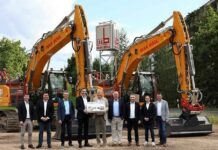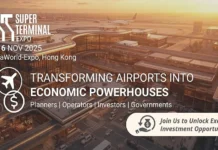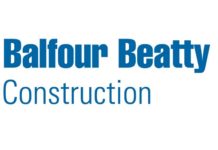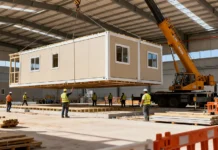The construction industry stands at a transformative crossroads. For decades, traditional on-site construction has dominated the landscape, with workers assembling buildings piece by piece under variable conditions and weather constraints. Today, a fundamental shift is underway. Modular and prefabricated construction represents not merely an alternative approach but a comprehensive reimagining of how we design, manufacture, and deploy buildings across the global infrastructure landscape.
The market speaks volumes about this transformation. The global modular and prefabricated construction market, valued at approximately $137.67 billion to $159.3 billion in 2024, is projected to expand significantly, reaching between $203.8 billion and $228.9 billion by 2030, with compound annual growth rates hovering between 4.2% and 7%. This explosive growth trajectory reflects an industry-wide recognition that prefabrication and modular systems offer tangible solutions to the construction sector’s most pressing challenges: escalating labor shortages, cost pressures, timeline delays, and environmental concerns.
The question is no longer whether modular construction will become mainstream—evidence from projects worldwide demonstrates it already has. The question now centers on how organizations can strategically implement offsite manufacturing to capture the substantial efficiency gains, cost savings, and sustainability benefits this approach delivers.
The Fundamental Shift: From Site-Centric to Factory-Optimized Construction
Traditional construction methodologies rely on sequential processes. Site preparation occurs first, followed by foundation work, then structural assembly, and finally systems integration. Weather becomes a constant adversary, pushing timelines backward with each rain event or extreme temperature. Labor availability fluctuates based on regional market dynamics. Quality inconsistencies emerge from variations in worker expertise, site conditions, and material handling practices.
Modular and prefabricated construction inverts this paradigm by moving production into controlled factory environments where precision manufacturing replaces improvisation. Components manufactured in factories achieve construction efficiency ratings of 70 to 80 percent, compared to efficiency levels as low as 30 percent for some traditional on-site construction operations. This dramatic difference in efficiency fundamentally alters project economics and timelines.
The Efficiency Revolution
The efficiency gains embedded within modular construction manufacturing processes stem from multiple converging factors. Factory environments enable standardized workflows, optimized machinery deployment, consistent quality controls, and continuous process improvement. Workers operate in familiar surroundings under predictable conditions, building muscle memory through repetitive tasks. This consistency translates directly into reduced errors, minimal rework, and superior product quality.
Consider a residential modular unit. In a factory setting, the same unit might be manufactured dozens of times in a single month. Each iteration benefits from lessons learned in previous iterations. Workers develop expertise specific to that unit configuration. Production processes become increasingly efficient. Quality benchmarks improve continuously. By contrast, traditional on-site construction often involves one-off scenarios where teams encounter unfamiliar challenges repeatedly without accumulating institutional knowledge.
Timeline Acceleration Through Parallel Processing
Perhaps the most significant operational advantage of offsite manufacturing involves the capability to execute parallel processes simultaneously. While site preparation and foundation work proceed on location, component manufacturing occurs concurrently in distant factories. This parallel workflow architecture compresses overall project duration dramatically.
Industry estimates indicate that modular and prefabricated construction can reduce project timelines by up to 20 percent compared to traditional methods. Some specialized applications have achieved even more dramatic reductions, with certain 3D-printed concrete applications reducing construction duration by approximately 95 percent. These timeline compressions transform project financing, allowing earlier occupancy and faster capital return on investment.
The Horlick High School mechanical system renovation in Racine, Wisconsin exemplifies this principle. By prefabricating key mechanical components including boiler modules, HVAC ductwork, and piping assemblies while site demolition and preparation proceeded simultaneously, the project achieved schedule acceleration while maintaining quality standards. The controlled factory environment shielded production from Wisconsin’s variable climate, eliminating weather-related delays that frequently disrupt traditional on-site mechanical work.
Economic Transformation Through Cost Optimization
Cost reduction represents a primary driver of modular construction adoption, but the mechanisms through which cost savings materialize deserve detailed examination. Understanding these mechanisms enables project managers to identify optimization opportunities within their specific contexts.
Labor Cost Restructuring
Offsite manufacturing requires fewer on-site workers during the assembly phase compared to traditional construction. Fewer workers on-site means reduced worker compensation expenditures, diminished site management overhead, and decreased logistics complexity. Labor costs, which typically represent 25 to 35 percent of total construction expenses in traditional projects, can be substantially reduced through prefabricated systems deployment.
The labor reduction extends beyond simple headcount reductions. Prefabrication reduces rework requirements—the process of correcting errors discovered during or after construction. Since rework typically consumes 5 to 15 percent of construction labor in traditional projects, eliminating or minimizing rework through factory-controlled quality represents a substantial cost advantage. Workers in controlled environments make fewer mistakes. Fewer mistakes mean less rework. Less rework means lower labor costs.
Material Waste Minimization
Prefabricated construction generates significantly less construction waste than traditional methods. Factory precision enables optimal material cutting, minimizing scrap. Standardized component designs reduce material variety, enabling bulk purchasing at lower per-unit costs. Just-in-time delivery logistics prevent excess inventory accumulation and associated storage costs.
Research indicates that offsite manufacturing operations often generate 30 to 50 percent less waste than comparable on-site operations. For large projects, this waste reduction translates into meaningful cost savings through reduced disposal fees, decreased material procurement requirements, and lower site management expenses.
Weather Independence Economics
Factory environments operate independent of weather conditions. Rain, snow, extreme heat, and high winds—environmental factors that halt or slow traditional construction—pose no obstacle to controlled factory operations. This weather independence translates directly into schedule reliability and cost predictability.
Traditional construction in challenging climates often experiences 10 to 20 percent schedule slip due to weather-related work stoppages. Each day of delay accumulates costs through extended supervision, equipment rental extensions, worker retention, and extended site management. By eliminating weather delays through factory production, modular and prefabricated construction delivers schedule certainty and cost predictability that traditional methods cannot match.
Supply Chain Optimization
Offsite manufacturing enables sophisticated supply chain management that traditional construction struggles to achieve. Long-lead items can be procured well in advance, manufactured into components, and staged for delivery exactly when needed. This just-in-time delivery approach minimizes inventory carrying costs, reduces the risk of material obsolescence, and optimizes warehouse space utilization.
The ability to forecast component requirements with precision enables bulk purchasing of raw materials at significant volume discounts. When projects can guarantee material volume and delivery schedules, suppliers offer pricing that independent projects cannot negotiate. These material cost reductions, while individually modest, aggregate into meaningful savings across large projects.
Quality Assurance and Structural Integrity
Modern construction demands uncompromising quality standards. Structural integrity, fire safety, thermal performance, and durability benchmarks admit no deviation. Modular and prefabricated construction not only meets these stringent requirements but often exceeds the quality standards achieved through traditional construction methods.
Factory-Controlled Quality Systems
Factories deploy comprehensive quality control systems that traditional construction sites struggle to replicate. Each component undergoes rigorous testing before shipment. Measurement precision exceeds on-site capabilities. Material specifications receive constant verification. These systematic quality controls dramatically reduce field quality issues.
When components arrive at construction sites, they have already been tested, verified, and approved. Site crews simply assemble pre-qualified components rather than fabricating components and hoping on-site quality inspection catches defects before installation. This shift from detection-after-fabrication to prevention-before-shipment fundamentally improves construction quality.
Permanent and Relocatable Modular Categories
The modular construction market segments into two primary categories: permanent and relocatable modular structures. Permanent modular construction, which represents approximately 61.3 percent of current market revenue, consists of modules designed for permanent installation meeting all building codes and durability requirements identical to traditional construction. These permanent structures provide comparable longevity and performance to conventional buildings while delivering the efficiency advantages of modular manufacturing.
Relocatable modular construction, representing the remaining market segment, provides flexibility for applications requiring temporary or flexible occupancy. Schools expanding temporarily, emergency housing after disasters, and seasonal facilities benefit from this relocatable architecture. The distinction between these categories demonstrates that modular and prefabricated construction encompasses diverse applications rather than representing a single construction approach.
Sustainability and Environmental Performance
Environmental considerations increasingly influence construction methodology selection. Building operations consume approximately 28 percent of global energy and generate 28 percent of global carbon dioxide emissions. Construction processes themselves consume significant energy and generate substantial waste. Offsite manufacturing and prefabricated systems address both direct and indirect environmental impacts.
Reduced Material Waste
Precision manufacturing in factories generates dramatically less construction waste than on-site construction. Factory operations recover scrap materials more systematically, enabling recycling and reuse. Material waste reduction reaches 30 to 50 percent compared to traditional construction, substantially reducing landfill contributions and embodied carbon associated with excess material procurement.
Transportation Efficiency Paradox
A common concern regarding modular and prefabricated construction involves transportation emissions associated with shipping components to project sites. While transportation generates some carbon emissions, the net environmental benefit of modular construction typically exceeds the transportation impact for several reasons. First, reduced project timelines mean fewer worker commutes to sites. Second, factory concentration of resources enables superior transportation optimization. Third, reduced on-site waste minimizes reverse transportation requirements. Fourth, early project completion reduces total operational carbon through earlier building occupancy and energy efficiency benefit realization.
Research indicates that despite transportation requirements, prefabricated construction achieves overall carbon reductions of 60 to 65 percent compared to traditional methods when considering the complete project lifecycle from material extraction through occupancy.
Energy-Efficient Building Systems Integration
Factory settings enable sophisticated building systems integration impossible to achieve efficiently on-site. Energy-efficient HVAC systems, high-performance insulation, and optimized lighting systems can be pre-assembled, tested, and integrated into modules before site installation. This pre-integration ensures optimal performance and eliminates on-site integration errors that compromise energy efficiency.
Three-dimensional printed concrete walls developed for high-performance buildings demonstrate this principle. These innovations achieve 50 percent improvements in thermal resistance compared to conventional construction while maintaining full structural performance at no additional cost. When embedded within modular and prefabricated construction processes, such innovations deliver sustainability benefits unavailable through traditional methods.
Sector-Specific Applications and Emerging Opportunities
Healthcare Infrastructure Expansion
Healthcare facilities present compelling applications for modular and prefabricated construction. Hospitals expanding capacity can leverage modular patient room modules, diagnostic facility modules, and support space modules to accelerate construction while maintaining strict infection control and regulatory compliance standards. Modular ICU facilities, surgical suite modules, and laboratory modules enable healthcare systems to expand capacity rapidly without disrupting ongoing operations.
Educational Infrastructure Development
Schools and universities increasingly deploy modular construction for classroom facilities, dormitory housing, and administrative buildings. Educational institutions value the timeline compression because expanded capacity becomes available for student occupancy at the beginning of academic periods rather than mid-year. Permanent modular classrooms meet all educational facility requirements while reducing construction timeline by 30 to 40 percent.
Affordable Housing Solutions
Urban housing shortages and affordability crises create urgent demand for construction methods enabling rapid, cost-effective housing delivery. Modular and prefabricated construction directly addresses this challenge through efficiency gains that reduce per-unit housing costs. The UK completed 56,971 affordable housing units during 2023-24, many utilizing modular construction methodology. India’s Pradhan Mantri Awas Yojana government housing scheme increasingly adopts modular approaches to meet ambitious housing delivery targets at reduced costs.
Disaster Recovery and Emergency Housing
When disasters strike, rapid shelter reconstruction becomes critical. Modular and prefabricated construction enables deployment of emergency housing, temporary medical facilities, and essential services infrastructure on timescales impossible through traditional construction. Government agencies and humanitarian organizations increasingly specify modular construction for disaster recovery applications where time represents the most critical resource.
Industrial and Infrastructure Projects
Large-scale infrastructure projects including manufacturing facilities, distribution centers, and utility installations benefit from modular construction methodologies. Coordinated prefabrication of structural systems, mechanical systems, and electrical systems enables infrastructure projects to compress schedules while maintaining integration quality. E-commerce facility expansion relies increasingly on modular construction to achieve rapid deployment of distribution infrastructure required by accelerating digital commerce growth.
Technology Integration and Future Evolution
Modular and prefabricated construction continues evolving through technological integration. Building Information Modeling (BIM) enables sophisticated design optimization before manufacturing commences. Robotics and automation increase manufacturing precision and labor productivity. Artificial intelligence optimizes production scheduling and quality control. These technological advances promise further efficiency improvements and cost reductions.
Design Optimization Through BIM
Building Information Modeling systems enable architects and engineers to explore design variations digitally before physical manufacturing. Generative design algorithms discover optimal configurations that human designers might overlook. Parametric modeling enables designs to adapt dynamically to changing requirements. These capabilities enable design optimization that enhances both manufacturing efficiency and building performance.
Automation and Robotics Integration
Advanced manufacturing facilities increasingly deploy robotic systems for repetitive tasks including material handling, precise cutting, controlled welding, and component assembly. These automated systems operate continuously without fatigue, ensuring consistent quality and accelerating production. As automation costs decline and technology matures, even smaller prefabrication operations become economically viable.
Hybrid Methodologies Emergence
Market evidence indicates increasing adoption of hybrid methodologies combining modular elements with selective on-site customization. This hybrid approach captures modular efficiency advantages while enabling architectural customeness and premium design differentiation. Developers in Asia-Pacific increasingly implement hybrid strategies for residential and mixed-use projects, proving that modular and prefabricated construction adapts to diverse architectural requirements rather than constraining design creativity.
Strategic Implementation Considerations
Organizations considering modular and prefabricated construction adoption should address several strategic considerations to maximize benefits realization.
Design Phase Optimization
Investment in design optimization during early phases yields disproportionate returns. Research demonstrates that increased design phase investment substantially reduces costs in subsequent production, transportation, and installation phases. Design decisions determining modular boundaries, connection strategies, and component standardization dramatically influence downstream efficiency.
Supply Chain Readiness
Successful modular construction requires supply chain infrastructure capable of supporting component production, quality assurance, and logistics coordination. Organizations lacking existing modular manufacturing capacity should evaluate partnerships with established modular construction providers rather than attempting to establish internal manufacturing capabilities without sufficient volume commitment.
Regulatory and Code Compliance
Building codes and regulatory frameworks increasingly accommodate modular and prefabricated construction, with permanent modular construction now accepted as equivalent to traditional construction across most jurisdictions. Project teams should verify code compliance early in project planning to eliminate regulatory uncertainty that could delay approvals.
Stakeholder Communication
Success requires educating project stakeholders about modular construction benefits and addressing legitimate concerns regarding aesthetic, performance, and long-term durability. Demonstrating successful precedent projects and providing transparent quality documentation builds confidence and overcomes adoption resistance.
Conclusion: The Inevitable Transition
Modular and prefabricated construction represents the future trajectory of the construction industry rather than a niche alternative. Market projections anticipating growth to $228.9 billion by 2030 underscore the transformative nature of this shift. The combination of economic advantages, quality benefits, timeline compression, and environmental performance creates compelling rationale for adoption across diverse project types and geographic markets.
For construction organizations, developers, and institutions confronting complex projects, challenging timelines, and cost constraints, modular and prefabricated construction offers proven solutions. The evidence from successful projects worldwide—from high-rise residential development to healthcare facilities to disaster recovery housing—demonstrates that this approach delivers promised benefits reliably and consistently.
The construction industry’s evolution toward offsite manufacturing and modular systems will fundamentally reshape how the built environment develops over the coming decades. Organizations embracing this transformation position themselves advantageously to compete in an evolving marketplace, while those remaining committed exclusively to traditional methods risk obsolescence as market preferences and competitive pressures accelerate the transition. The future of construction has arrived, and it is distinctly modular.





























